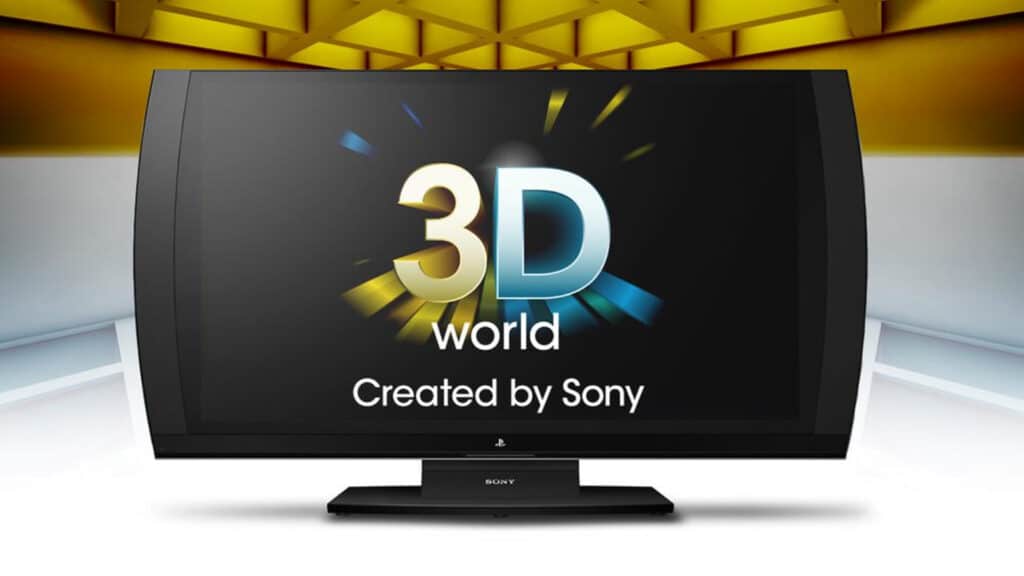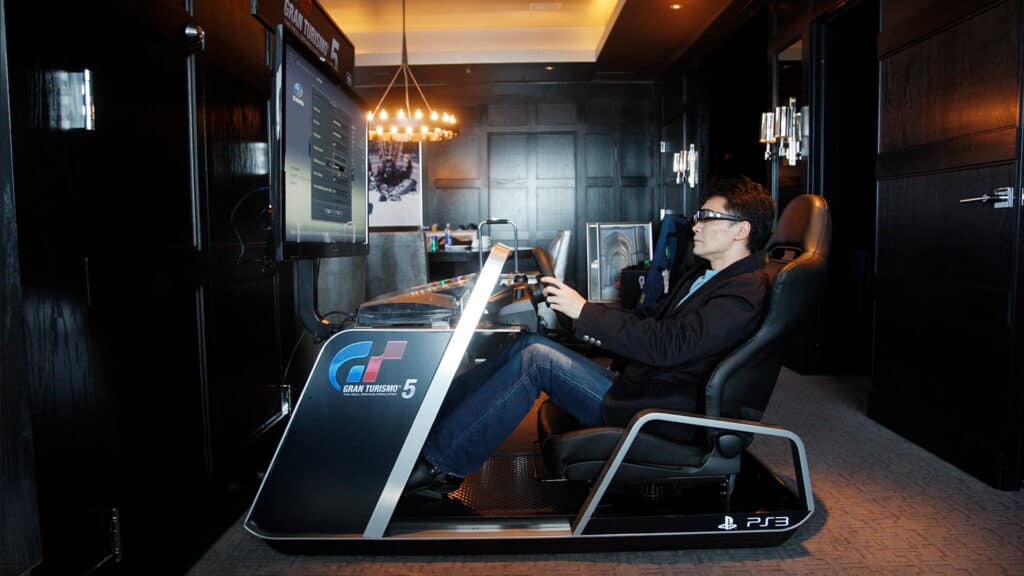By Justin Melillo, Ross McGregor, Nick Saunders and Thomas Harrison-Lord
The Gran Turismo array of racing video games has always been filled with distinctive quirks, while series producer Kazunori Yamauchi is famed for his eccentricities and elusiveness.
Sometimes, these features can be taken as unnecessary fripperies, taking away development time and resource from more pertinent challenges. Often, they simply aren’t used by most players who tend to be more interesting in the number of venues or vehicles on offer.

But they also add a sense of charm – something that is rarely found elsewhere in this genre. GT games are enigmatic. They distinguish themselves from contemporary rivals, eschewing the norm.
Over the last 25 years, the license tests, ranked online races and used car dealerships have been emphatic success stories. The home printer integration on the PlayStation 2, less so…
As we impatiently wait for Gran Turismo 7 on 4th March, hopefully, this weird and wonderful compendium helps explain why Gran Turismo is one of the most cherished racing games.
On-demand video service – Gran Turismo TV
Gran Turismo 5 Prologue
Not only was 2007’s Gran Turismo 5 Prologue a testbed for the upcoming fifth main instalment, but it also featured the strange addition of Gran Turismo TV.
Yes, there was an on-demand video download store and player within the game.
It included a smattering of free content, but you could also purchase items such as Super GT racing highlights or episodes of Japan’s endearing Best Motoring. It wasn’t the only car review show on their either, as Clarkson, Hammond and May also made an appearance for £0.69 an episode.
“We at Polyphony are great fans of the world’s best motoring programme, Top Gear, so we’re delighted to be collaborating with BBC Worldwide to deliver Top Gear content via Gran Turismo,” said Kazunori Yamauchi ahead of the platform’s launch.

Described as a “dedicated online channel packed with the latest news and content from the motoring world” it was shackled by not being able to watch the videos outside of the game.
Also, after the initial flurry of automotive content, new additions soon dried up and ultimately stopped in 2009.
However, if there was an automotive-based subscription service that pooled programming from multiple sources, I would still be interested to this day. Perhaps GT TV was just too future-gazing in its scope.

Course Maker and Path Editor
Gran Turismo 5 and Gran Turismo 6
The Course Maker was introduced in Gran Turismo 5 and hotly anticipated. Finally being able to make your own tracks in Gran Turismo was a big deal.
Upon opening the Course Maker you were greeted with a choice of locations with a variety of surface types that your track could be based on. Once you selected from the options, you were presented with a selection of sliders you could adjust to your liking.
Adding more sections made your course longer, you could set the time of day and select a point-to-point venue or a circuit.

You then adjusted parameters such as complexity, corner tightness and banking levels upon viewing a top-down preview of your track.
Sadly, instead of a fully-feature track creator, you just toggled a few options and the game generated an approximation.
The main issue was that whatever your created, it was bland and lacking decoration, meaning the tracks lacked soul or character and were often impossible to learn as everything looked the same.
This was built upon in the sixth title with the ‘Path Editor’. As you can tell me its name, no, it wasn’t necessarily a true venue creator either.
This time you used a tablet-only app to plan out your routes. You could take pictures of real-world tracks and then trace over them using your index finger on the tablet screen, plus add/remove track furniture.
But this suffered from being unintuitive and the tracks suffered from the same lack of fizz like Gran Turismo 5. It also arrived nearly two years after the game’s initial launch.
A new dimension – 3D
Gran Turismo 5
The year is 2010 and the future has arrived. Maybe.
Television manufacturers such as Sony were launching sets that promised an extra dimension through the use of active shutter glasses. This, in theory, delivered a much more involved 3D experience to the ‘RealD’ used in cinemas.
The PlayStation 3 went all-in with several games working in 3D. There was even a PlayStation-branded 3D Display launched a year later.

Tying in with the hubbub, was, of course, Gran Turismo. The fifth release – as you are now hopefully cottoning on to, was packed to the gills with innovation – supported the then-nascent technology, adding extra depth in particular when driving with the cockpit camera.
Even more ephemeral was the UK-market launch, which involved a 3D racing competition in HMV stores, with a ‘3D GT5’ champion ultimately crowned.
“Combine the advanced technology found in all Sony 3D TVs, the PlayStation3 console and the hugely advanced GT5 – and you’ve got a gaming experience that’s second to none,” claimed Christian Brown, Sony UK’s Senior Category Marketing Manager at the time.

Surprisingly, the effect was, and I’m going to say this, good. It was actually good. But the TVs were mostly expensive, the glasses needed charging and it was a bit of a faff. 3D game and film releases have long since dried up, although Amazon does still have Sony’s glasses available with Prime next-day delivery, oddly…
Printing your drift pics
Gran Turismo 4
Gran Turismo 4 introduced the revolutionary Photo Mode. This is to be filed under a separate ‘best Gran Turismo features’ list.
When it comes to the weird though, the option to print is definitely worth a mention.

Since the PlayStation 2’s network connectivity was rudimentary at best and the worldwide launch of Facebook outside of universities still some years away, the option of connecting a printer was the mid-’00s way of sharing an image.
The feature allowed you to hook up your parent’s Epson and, at a ruinously expensive cost per print, create physical interpretations of your best in-game images.
Once you had taken a picture using the SLR-aping in-game controls and connected a compatible printer via USB, there was a dedicated ‘Photo Lab’ area that included native printing options such as paper type, image size and quantity of copies.

A guide to printing directly from Gran Turismo 4 is still listed on the Epson New Zealand support website, although I doubt the Sony hotline listed at the bottom will be much help in 2022.
Driver management in B-Spec mode
Gran Turismo 4, 5 and 6
B-Spec was a separate game mode analogous to a racing manager simulator. You would loosely oversee an AI-controller driver in a race from your viewing angle of a race replay.
As the race started, commands were issued to your driver (who became affectionately known as ‘B-Spec Bobs’ in the GT community) telling them to drive at a pace between one and five or to overtake.
Intriguingly, you could level up your driver by having him compete in different cars and tracks, improving as they learnt. In theory that is.

In practice ‘Bob’ would get faster but still was prone to inexplicable behaviour and many, many spins or crashes. You could even share a drive with your Bob and get them to take over for you during races that required pit stops – if you fancied a break or inexpiably losing the lead.
In the end, you ended up forming a bond with your haphazard driver, which would be instantly broken when they did something stupid. Still, a bond nonetheless and just like the game series itself, charming.
Gran Turismo 5 took the Bobs to a whole new level by making them not Bobs anymore and allowing them to be named using a random name generator. The driving skill levels had been altered too.

To avoid issues with real names coming up they only had surnames and a first initial, but it could still lead to some interesting names. My main B-Spec driver was a certain N.Drake of Uncharted fame, but you could have up to six of them with different personality traits and performance.
Gran Turismo 6 was deemed by many as a slight backward step in terms of the B-Spec options, as it was a hybrid of the preceding two games but jettisoned the most interesting parts of both. And with that, the feature has yet to return since.
Cursed NASCAR cars
Gran Turismo 5 (Again)
Ah yes, it turns out in retrospect that Gran Turismo 5 was a melting pot of interesting ideas. It’s notable for including official NASCAR and WRC licences, alongside the superlative Shuffle Races and GT Academy esports events.
“NASCAR drivers are big fans of Gran Turismo,” said Blake Davidson, NASCAR’s then Managing Director, Licensed Products.
“Dale Earnhardt Jr. himself actually came to us and said ‘you really need to look at Polyphony Digital, they’re a great developer’ [and so] for [the drivers] to be in this product I think really demonstrates just how far NASCAR has come.”

However, if Jeff Gordon shouting “green, green, green” wasn’t strange enough during the NASCAR challenges, the cars certainly were.
2010 was an off-colour year for NASCAR rule makers in general. Since 2007, these new-at-the-time NASCAR Cars of Tomorrow, or COT, featured a rear wing and a new front end splitter. Midway through the 2010 season, the COT’s rear wing was finally ditched, and the rear spoiler returned for good.
The mixed, “cursed”, COT saw out the remainder of the 2010 season with the half-fix for the car, combining the 2009 nose, featuring the splitter rods, together with the returning spoiler. The design was later changed to incorporate a more sleek front end which debuted in 2011, but these rarer, half-altered cars are featured in Gran Turismo 5, helping these beasts live on in perpetuity.
The Moon
Gran Turismo 6
Oh, Gran Turismo, we love you to the Moon and back.
Quite literally.

In a frankly bizarre move, Polyphony Digital transported us to the surface of the Moon where the player was presented with three driving missions at the wheel of a Moon buggy – otherwise known as a Lunar Roving Vehicle (LRV).
Mimicking the Apollo 15 NASA mission to the Moon in 1971, your first driving challenge is to follow the actual route astronauts David Scott and James Irwin took during their explorative trip across the lunar surface.

It sounds exciting, right? Well, in practice, the experience does not translate well to gaming. The simulated lack of gravity means your Rover is nigh-on impossible to keep off its roof traversing small crests, meaning lunar travel is slow, frustrating, and monotonous.
In fact, driving an actual British Leyland-era Rover would be more thrilling.
That is our look into the weirdest Gran Turismo features, but let us know in the comments below if you can think of further suggestions. We have not touched upon VR, standard vs premium quality cars, memory card battles and the music soundtracks, for example…
Image source: PlayStation Blog





Chat with the Community
Sign Up To CommentIt's completely Free